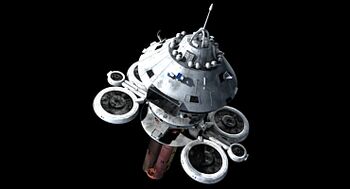Regula class
The Regula series of stations were designed as small, flexible platforms for long-duration scientific missions in isolated locations. These kinds of missions could last for years, keeping a science team on station for that length of time would require the commitment of either a major starship asset or a fleet of small science vessels relieving one another every few months. Either of these was a significant draw on resources, while a small fixed station would offer the same capability at a fraction of the resources.
In the 2340's, faced with the same problem they were having with the Spacedock-class of base, Starfleet decided to field two new bases. Both bases were based on the Regula design, but were scaled up to provide the room for enhanced capabilities and starship accomodation. Two types of bases were fielded, both had the same starship support functions, yet one was geared for sector/system defence and command and the other for deep space scientific research.
The scientific version of the Regula boasts impressive science capabilities and, along with its precedessor, has a modular approach to it's scientific platforms, allowing various bases to be configured with different instruments, such as a large telescope as seen on Starbase 173.
Compared to the scientific sub-type, the combat-orientated design has reduced scientific facilities and a reduced capability to handle civilian traffic. The base is also designed to operate largely within planetary systems, and as such lacks large bulk cargo and fuel containers. More space is given over to weaponry, with roughly double the armament. The shield generator is identical between the two stations, but the removal of the cargo containers means that this type's shields need to cover a significantly smaller volume, thereby increasing their overall strength.
Regula class bases are a common sight around the Federation.
Auxiliary Craft
Shuttlebays: 12
Fighters
- Broadsword Multi-role Assault Fighter: 12
- Peregrine Heavy Fighter: 6
- Razor Interceptor: 18
- Valkyrie Space Superiority Fighter: 24
Runabouts
Shuttles
- Hunley Shuttle: 2
- Type 11 Shuttle: 12
- Type 6 Shuttle: 24
- Type 7 Shuttle: 24
- Type 8 Shuttle: 36
- Type 9 Shuttle: 24
Transports
Armament
Phasers
- Type XII Array: 52
Shielding Systems
Torpedoes
- Burst-Fire Torpedo Launcher: 8
- Quantum Torpedoes: 500
- Photon Torpedoes: 350
- Tri-Cobalt Devices: 100
| Starfleet Starship Classes (Active) | |
| Research Bases | Argus class - Lowell class |
| Starbases | Nor class - Regula class - Stardock class |
| Cruisers | Ambassador class - Galaxy class - Nebula class - Prometheus class - Sovereign class |
| Light Cruisers | Akira class - Cheyenne class - Excelsior class - Intrepid class - Luna class - Normandy class - Norway class |
| Research Vessels | Nova class - Olympic class - Oberth class |
| Escorts | Centaur class - Defiant class - Miranda class - New Orleans class - Sabre class - Steamrunner class |
